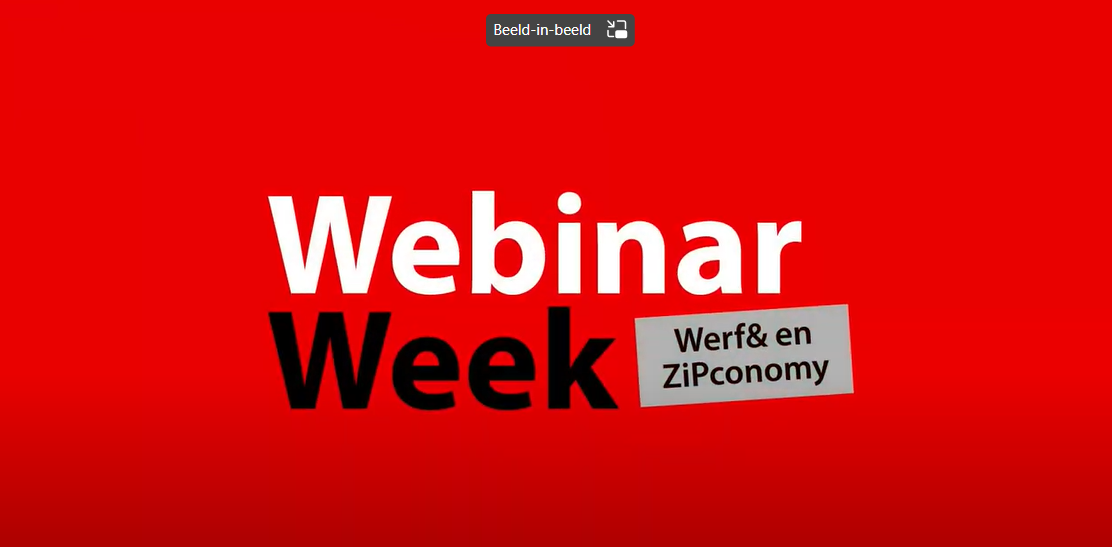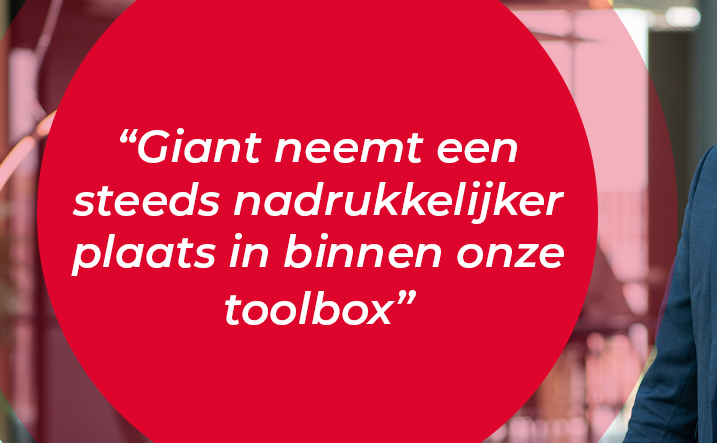Self-employed workers more likely to work for multiple clients
Self-employed workers more likely to work for multiple clients
Highly educated self-employed workers increasingly have more than three clients per year. In addition, the number of zzp'ers providing their own labor to organizations is declining slightly and only 2.7 percent of zzp'ers are working as entrepreneurs because the organization suggested this form of contract. This is according to a new research report on zzp'ers. Marion van Happen, CEO HeadFirst Group: "Zzp'ers are entrepreneurial and are rarely forced into zzp-ship. These are important insights for politicians in The Hague."
The outgoing cabinet is working on new policies to reduce false self-employment. The difference between zzp'ers with many and few clients is very relevant. The minister wants the criterion 'organizational embedding' to weigh more heavily in the assessment of whether someone may be hired as a self-employed person. Someone who works many hours for one organization is more likely to meet this standard than an entrepreneur who works for many different clients. The percentage of self-employed individuals who depend on a limited number of clients per year has dropped significantly. In 2021, 42 percent (240,000) of the self-employed who offer their own labor still had a maximum of three clients; now it is 35 percent (210,000).
Incorrect assumptions
These figures come from the research report called 'Grip op het zzp-dossier', which was compiled by knowledge platform ZiPconomy, commissioned by HR tech service provider HeadFirst Group and entrepreneurs' organization ONL voor Ondernemers. The initiators aim to bring relevant, independent facts to light. This is important for the public debate on the position of self-employed people in the labor market, which regularly takes place on the basis of incorrect assumptions.
For example, it suggests that companies are forcing employees to become self-employed. Figures from the Central Bureau of Statistics (CBS) and TNO show the opposite. Only 2.7 percent of zzp'ers are working as entrepreneurs because the client suggests this form of contract. Marion van Happen, CEO HeadFirst Group, says: "These figures show that forced self-employment is minimal. The majority of zzp'ers consciously choose self-employment."
Share of self-employed own labor declines
Furthermore, while the number of self-employed workers appears to be growing, the share of self-employed workers offering their own labor is actually declining. Thus, the overall growth of the self-employed is mainly driven by self-employed people selling products (+10 percent). This is striking, given that the political discussion focuses exclusively on self-employed people who are hired.
"The cabinet aims for more permanent employment contracts and fewer flexible employment relationships, but the measures to achieve this also affect entrepreneurs who do not compete with employees," explained chairman Hans Biesheuvel of ONL voor Ondernemers. For example, small shopkeepers, manufacturers and other self-employed people who sell their products are also affected by the phasing out of the self-employment deduction and the SME profit exemption."
More facts and figures about the self-employed
The report contains numerous other valuable insights regarding the self-employed. For example, 83 percent of the self-employed were found to be (very) satisfied with their current work situation, which is a slight increase from 2021. Among employees, this percentage is 78 percent. Moreover, self-employed workers are less worried about the future than ever: 61 percent of self-employed workers who offer their own labor are not worried at all. This is the highest percentage since the first survey by CBS and TNO in 2013. Download the full report here.
The job market is normalizing. "But sitting still is not an option."
The job market is normalizing. "But sitting still is not an option."
In the podcast ZiPtalk, we spoke with Simone Groeneveld (HeadFirst Group) and Geert-Jan Waasdorp (Intelligence Group) about what insights data can provide to achieve a more integrated talent acquisition strategy.
The tightness around the labor market is easing slightly, the growth in the number of self-employed workers is declining, the number of responses to assignments is rising slightly again, and rates of interim workers are rising less rapidly than wages.
These are relevant and interesting figures, but it does not mean that the labor market is turning around. The shortage remains, the situation remains that workers have the choice. So employers will not be able to sit still, according to Simone Groeneveld (HeadFirst Group) and Geert-Jan Waasdorp (Intelligence Group) in an episode of ZiPtalk on the occasion of the tenth Talent Monitor that both companies publish every quarter.
Waasdorp speaks of a "normalization" of labor market. "All data points are at the historical, highest or lowest level. Take, for example, the number of responses to an assignment. That was at the lowest point ever measured. Now there are some more responses again." Still, tightness remains, according to Waasdorp: "We are going from an extremely tight market to a very tight market."
Groeneveld does see important differences in sector. "In the corner of energy transition, of course, an awful lot is happening. There the demand for talent is enormous. And that will only increase in the coming years." In governments, demand is decreasing somewhat. In healthcare, she sees organizations struggling to balance 'permanent and flex' more.
Total talent
That also brings the conversation right to the different forms of work and contract types. The tight labor market is forcing employers to look beyond traditional permanent jobs. Now that the very sharpest edges of the shortage are off, employers may be able to regain a little more control.
Waasdorp and Groeneveld do think it is a must to develop a "total talent strategy. Waasdorp: "An integral, holistic view of organizing human resources, I still see much, much too little of that." The extreme shortage meant that recruiters (permanent) and hiring (flex) did have to work together. Waasdorp does not hope that the slightly decreasing tightness will cause everyone to go back to "their own island."
Data
No strategy without understanding data. Both agreed on that as well. In practice, Groeneveld sees a number of organizations taking steps to have an integrated view of their "talent intelligence.
According to Waasdorp, it can be done. There is more than enough data. But you have to work with it. He advises making someone in the organization responsible for that talent intelligence who does not come from the 'silos' of HR or hiring, but is just outside them. And who understands data analysis.
Listen or watch
Listen/view the episode of ZiPtalk for more tips on 'talent data' and how to use it for a total talent strategy. And catch this week's news as well:
Source: ZipConomy
Who do you need in the future? Convince with data.
Who do you need in the future? Convince with data.
As an HR manager, data analytics can help you in many ways. Paul Oldenburg and Ton Sluiter of HR tech service provider HeadFirst Group shared tips, insights and their own labor market data during Webinar Week.
Without suitable employees, an organization cannot grow. As logical as that sounds, it is often difficult for HR managers to convey that urgency to management. Data can help you do this. How? Paul Oldenburg and Ton Sluiter of HR tech service provider HeadFirst Group told us during Webinar Week.
Methodology from Gartner Group
"You can use data to discover talent risks to business strategy execution and then take action," Oldenburg says. "Based on your strategic goals, you can assess what talent you need to grow your business. Then you map out what your employee base and job market look like, now and in the long term. In this way, you will discover whether you will soon be short of people, what problems that poses, and how to solve them."
HeadFirst Group, for example, uses a methodology from consultant Gartner Group to use data to define, identify and mitigate key risks around strategic workforce planning. "Make it measurable," Oldenburg says. "That helps you speak the language of the board: risk management. That is how you become more relevant as an HR manager, because then it becomes clear that you are talking about concrete steps to secure the future of the company."
Talent risks for organizations
A talent risk is a shortage of suitable personnel to meet your organization's goals, Oldenburg explains. In the webinar, he shows a so-called "risk catalog" of the biggest talent risks for organizations.
Some of the most common risks are:
- Lack of supply of talent
- Labor market competition
- Talent Development
- Pipeline risk (a lack of competencies for the future)
Your organization probably faces several risks. Once you've mapped out the opportunities and impact for each risk, you'll be able to set priorities. Next, you will work to mitigate the most important risks for your organization.
Analysis from HeadFirst Group
Data manager Sluiter then shows in a few slides what data HeadFirst Group analyzes itself. For example, he has an interactive overview of rates for professionals (self-employed or employed by suppliers) in various professional groups. "We have a database containing the rates agreed upon for all assignments," he says. "As a result, we know what a java developer costs on average. We use this kind of insight to inform recruiters. We can also show clients whether they are paying a market-based rate."
HeadFirst Group can also make predictions, as deals are already being signed for future quarters. "For example, we see that the rate for certain professional groups will increase soon," says Sluiter. "In addition, we look at recruitment feasibility. When we put out an assignment, how many people are interested? For example, we know that a full-stack developer is currently less scarce than a java developer."
Meanwhile, HeadFirst continues to expand its database and analyses. "Permanent positions are becoming less relevant, for example, which is why we are developing a method to analyze skills supply and demand," Oldenburg says. "That way we can search and train people even more specifically to be ready for the future."
Want to know more?
Watch the video below. After this webinar, you will know:
- How to convince your organization to invest in workforce planning.
- How to use data to make risk measurable.
- How to compare your organization's workforce planning with others in your industry.
Furthermore, HeadFirst Group invites you to an interactive working lunch at the head office in Hoofddorp. There you will exchange ideas and learn from experts and peers in the field of talent management and risk management. Components of the workshop:
- Set up sample risk catalog
- Establish indicators to make likelihood and impact of these risks measurable
- Identify data sources to report to Business leaders in own organization
Would you like to participate? Share your interest at marketing@headfirst.nl
Source: ZipConomy
Minister Van Gennip comes up with new criteria for hiring zzp
Friday, October 6, the bill 'clarifying assessment of employment relationships and the legal presumption' was made public through an internet consultation. With this bill, outgoing minister Van Gennip (Social Affairs and Employment) wants to replace the DBA law and further clarify the legislation around 'working in the service of'.
Three criteria for self-employment
The minister aims to achieve this clarification with three criteria:
- Work content management
- Organizational embedding
- Working at your own expense and risk
Together, these three criteria determine whether an assignment can be performed by a self-employed person, or whether it is still an employment contract.
Legal presumption of employment contract
In addition, as part of the overall bill, a legal presumption of employment contract is also introduced under the €32.24 rate. This proposal should strengthen the position of vulnerable workers at the base of the labor market. This is a civil law legal presumption that can be invoked by the worker himself. It is not about a minimum rate, but the legal presumption should make it easier for workers to claim an employment contract. The response to this is generally positive.
Reaction to legislative proposal
As an organization, we have good contact with the major zzp organizations and relevant industry associations (ABU, NBBU, VvDN, Bovib and RIM). On Tuesday, October 10, we met directly to discuss the latest developments. Several zzp organizations have already criticized the bill. HeadFirst Group will also respond to this bill itself, by preparing a position paper. Read our reaction to the bill here.
The Internet consultation runs until November 10, 2023. If the cabinet then sticks to this plan, a discussion in the Lower House will follow. Naturally, we will keep you informed of relevant developments.
Budget Day 2023: what's in store?
Last Tuesday was the third Tuesday of September and that means Prince's Day! This year it was a Budget Day in special times. This is because the Rutte IV government is outgoing and for that reason is not allowed to announce grand plans and throw money around. Also, government finances are coming under increasing pressure and most political parties are already gearing up for the Lower House elections in November. In Hague terms: a "policy-poor" budget without too many major decisions. On this page an overview of the most relevant plans and measures.
- SME profit exemption further reduced
The SME profit exemption will be reduced from 14% to 12.7% as of Jan. 1, 2024. The SME profit exemption is a scheme that reduces taxable profits after the entrepreneurial deduction. Entrepreneurs who make use of this scheme will thereby start paying taxes on a larger portion of their profit or income. Entrepreneurs with the highest profits lose the most financially.
- Reduction in self-employment deduction continues
Since 2020, the self-employed deduction has been reduced in steps. In 2024, the deduction will be reduced by an amount of €1280. The self-employed deduction will then come to an amount of €3750. Until 2027, this reduction continues to an amount of €900. This fits into the broader policy of the government to create a more level playing field between employees and the self-employed.
- Increase in untaxed travel reimbursement
The untaxed mileage allowance goes up from €0.21 to €0.23 in 2024. As an entrepreneur, you may deduct this amount from the profit for business trips with a private car, motorcycle or bicycle. As an employer, you may also give your staff a tax-free reimbursement of €0.23 per kilometer. This applies to commuting and other business travel by private vehicle.
- Austerity of Energy Investment Deduction
If you invest in energy-saving measures and sustainable business assets, you may be eligible for the Energy Investment Allowance (EIA). A percentage of the costs of that investment can then be deducted from the profit. As a result, less tax is paid. The EIA for entrepreneurs will be extended until 2028. The percentage that may be deducted does drop from 45.5% to 40% in 2024. The investment is minimum €2500 and maximum €136 million. So it may be wise to make another large investment in 2023 to take advantage of the 45.5% rate.
- Box 1 income from employment, benefits or home ownership
Your income in box 1 is taxed in two brackets. In 2024, you will pay 36.97% tax on your income up to 75,624 euros. That is 0.04 percentage points more than in 2023. On your income above 75,624 euros you will pay 49.5% income tax next year, the same as in 2023. The amount of the bracket limits went up other years by the rate of inflation. This year, the increase is 3.55%. That's less than the inflation rate of 9.9%. You're more likely to pay the higher rate of the second bracket because of this.
- Box 2 stock ownership income
If you own 5% or more of the shares in a company, you have a "substantial interest. You may then receive profit distributions, also called dividends. In 2023, you paid 26.9% tax on this. In 2024, dividends received from substantial interest will be taxed in a two-tier system. On income up to 67,000 euros, you pay 24.5% tax. On everything above that, the rate is 31%.
In 2024, you pay less tax in Box 2 on profit distributions up to about €106,000. On higher profit distributions, you will pay more tax in 2024 than in 2023. So it may be interesting for you to distribute accumulated profits in the company still in 2023. It may be interesting for you to distribute accumulated profits in your company still in 2023. Consult with your advisor. Note: After a dividend distribution, you have money and investments in private. It is then capital in box 3. There is a tax-free capital of 57,000 euros in box 3. If the value exceeds this exemption, you pay tax on this in box 3.
- Income-related health insurance law contribution
As an employer, you pay an employer healthcare insurance law levy on employees' wages. In 2024, this contribution is 6.57% over a maximum of €71,624. In 2023, the contribution was still 6.68% over a maximum of €65,952. This income-related healthcare insurance law contribution is part of the payroll tax.
On the entrepreneurial income, you pay the income-related health insurance law contribution yourself. For this, a rate of 5.32% on the maximum contribution income of €71,624 applies in 2024. The rate in 2023 was 5.43%. You will receive the (provisional) assessment for the income-related healthcare insurance act contribution at the same time as the (provisional) tax assessment.
- Further develop legislation and strengthen enforcement
Officials at the Ministry of Social Affairs and Employment continue to work on the bill to have a clearer distinction between self-employed workers and employees. This bill covers the criteria of "authority," "embedding," and "self-employment. It is expected that within now and a few weeks the draft bill will be published through an Internet consultation. The Tax Administration will also continue to work towards lifting the enforcement moratorium in order to improve the enforcement on false self-employment.
Finally, work continues on the legal presumption of employment below a certain hourly rate (between €30 and €35 per hour). Should a worker earn less than this hourly rate, there is a legal presumption of employment. It is then up to the worker to prove that this is not the case.
Men listen better to men. And we need more men using that privilege
Numerous studies underscore the benefits of gender equality in management teams. Yet most leadership positions are still held by men. While this is often seen as a cause of inequality, we believe this presents an unparalleled opportunity for men to take a proactive role in promoting gender equality within organizations. How they can do this was discussed at the Men as Advocates for Women's Visibility, a well-attended Summit where both Chairman of the Board Han Kolff and Managing Director Professionals & Partners Services Florine Onderwijzer were on stage.
To benefit from diversity, organizations must create a culture where equality is valued and where differences are seen as opportunities to learn and interact. Men have an important role in fostering positive change by using their influence and privilege to promote equality. This requires actively listening to others, having difficult conversations and speaking out against behaviors that get in the way of a culture of learning, respect and equality. It is not an easy task, but those who are truly committed to these actions will understand that a diverse workforce is better, even though it may seem more difficult at first. In doing so, they will also realize that increasing the visibility and representation of women comes from the collective effort of committing to these actions and the lessons learned along the way.
"You can't do it alone"
BrandedU aims to increase the visibility of women in business and achieve equal gender representation in leadership roles. That's why BrandedU launched "Men as Advocates" three years ago: an annual event to invite men to the conversation about gender equality. The third edition in June 2023 was all about turning strategies into action and about being able to learn from the efforts of other (male) advocates. All the outcomes of this event have been compiled into an inspiring white paper.
Download the white paper here > whitepaper23 (brandedu.co.uk)
Take the robot out of the human
Marijn van de Poel is managing director of Ciphix. This innovative company's mission is "Take the robot out of the human," he says. "With about sixty specialists, we automate as many routine tasks and cognitive decisions at our clients as possible. Using Hyperautomation technologies, such as Robotic Process Automation (RPA), Artificial Intelligence (AI), Process Mining and Low-code, we develop 'digital assistants' so that clients' existing employees can focus entirely on more important and interesting things."
"The latter is crucial. Everyone today is struggling with staff shortages, and that's precisely when it's a waste to have well-qualified employees spend time on repetitive work. People want to get to work on new challenges and customer requests, which stimulates and inspires them. When people spend less time on routine jobs, you keep the work fun and interesting and they continue to choose you. That's what Ciphix is betting on."
Balance between tech and touch
How that works, Marijn explains using the first digital assistants Ciphix introduced at HeadFirst Group: "HeadFirst Group handles tens of thousands of hiring transactions every year. A complex process with an application, publication, matching and finally a contract. With the help of the digital assistant, named Benthe, in 2022 we have, among other things, fully automated the reading of assignments. The process is flawless and much faster, while recruiters now have more time left over for the matching itself. It actually creates a better balance between tech and touch, as they call it at HeadFirst Group."
Streamer
"The process is error-free and much faster, while recruiters now have more time left over for the matching itself."
Bring human into the robot
"And we are already looking further together. Artificial intelligence, for example, makes it possible to analyze and interpret the data in applications and resumes faster and smarter, thus providing recruiters with better content support as well. It's just one of the possibilities and the great thing is that HeadFirst Group is completely in the lead. Our technical solutions help with what you want to achieve, but the organization itself has to have the mindset to want to work differently."
"By the way, why do we use real names? It's very deliberate because that way we make our solutions more recognizable and also bring a bit of the 'Human in the Robot.' New software with a techy name doesn't say much to most people. No one really likes SAP or Office, but everyone loves Benthe!"
IRS puts an end to 'free substitution' model agreement
Earlier this week, the Internal Revenue Service shared the notice that the approval of model agreements based on free substitution will be withdrawn as of Jan. 1, 2024. This decision is in response to their interpretation of the Supreme Court's ruling in the Deliveroo case. The Supreme Court ruled that only 'free substitution' can constitute employment. Clients and contractors should reassess the employment relationship before then if model agreements based on free substitution are used.
There are different types of model agreements that have been approved by the tax authorities in recent years. The use of an (approved) model agreement is not mandatory, it gives parties a certain degree of certainty that - if parties also behave in accordance with what is agreed in the model agreement - there is no question of false self-employment.
The Inland Revenue's decision does not affect working on an assignment through any of HeadFirst Group's labels. We use approved model agreements based on intervention. The criterion 'free substitution' is part of this model agreement, but not leading.
Duration of salaried employment grows toward duration of flex assignments
Whereas employees are employed for shorter and shorter periods, the length of the first assignment contract of independent professionals and secondees is actually increasing. Thereby, the percentage of assignments that are extended after this first contract is also growing. This is evident from the latest Talent Monitor of labor market data specialist Intelligence Group and HR - tech service provider HeadFirst Group.
Fixed more mobile, flex more sustainable
The number of years people are employed by the same organization is decreasing rapidly. On average, a person works for an employer for less than five years. Compared to 2015, this is a decrease of more than three years, when people stayed with an employer for an average of eight years. Looking at the flexible labor market, the average duration of an initial assignment of independent professionals and secondees was 205 days in 2022. For secondees, this was just slightly lower at 202 days, while for assignments of independent professionals it was a week longer at 209 days. For both groups, initial assignment duration has been increasing since 2020 and is now almost 3 weeks longer on average.
Geert-Jan Waasdorp, director and founder of Intelligence Group: "In the trade-off between permanent and flex, the differences in duration are getting smaller, but the differences in risk are getting bigger. Especially because of the greatly increased mobility and absenteeism. In some cases, job security for employers has become greater at the point when they turn to the flexible labor market than when they fall back on employed people, with or without a permanent contract."
Assignments increasingly extended
In addition, more than the majority of assignments are extended, with an average extension often around 6 months. In 2020, 63 percent of assignments were extended. That dropped to 56 percent in 2021, before "recovering" to 61 percent in 2022. Extensions, especially more frequent ones, also show an increase in the length of extensions compared to previous years.
Assignments - with or without extension - averaged 395 days in 2020. This duration is getting closer to the declining average of the duration that a young person up to 25 years is employed by an employer, which is now well under three years. Marion van Happen, CEO HeadFirst Group: "Never before in our Talent Monitors have we seen permanent and flex come closer together so concretely AND never before have we seen that substantiated, data-driven Total Talent Management is not just a trendy term, but a business-critical necessity."
The full Talent Monitor 'Fixed is getting more mobile and flex is getting more sustainable' can be read here.
Giant occupies an increasingly prominent place in our toolbox
HeadFirst Group collaborates with Intelligence Group in writing quarterly reports on developments in the permanent and flexible labor market; the Talent Monitor. In addition, the organizations exchange data on fixed and flex. HeadFirst also works with Giant, including the new Fixed and Flex feature.
The Permanent and Flex dashboard provides insight into flexible workers and compares them to permanent employees. This allows the user to formulate a Total Talent Acquistion strategy in minutes. The new dashboard compares recruitment feasibility; monthly salary/hourly rate; key pull factors and flex/zzp market share.
Why is HeadFirst using Giant and the new Fixed and Flex feature?
Bart van der Geest, Head of Marketing and Communications at HeadFirst Group, explains, "We have been working with Giant for about six months now. We are originally a service provider in the professionals segment in the flexible labor market, but within the group we have now also had solutions for permanent employment for years. We offer Total Talent Acquisition (TTA). At the same time, we are moving from a specialist in recruitment and compliance to a strategic partner where we really want to be a data-driven consultant for our clients. In both developments Giant fits perfectly.'
HeadFirst Group uses Giant for its own internal HR strategy, but also to better serve clients. 'We are moving from a specialist in recruitment and compliance to a strategic partner where we really are a data-driven consultant for our clients. We combine our large amount of proprietary data with external data from Intelligence Group, which allows us to offer unique insights that others cannot. We bring this to existing clients, but our bid management department also uses this data to concretely substantiate tenders and offers in tender processes.'
Van der Geest also relates the use of Giant to the purpose of HeadFirst Group: 'join the next world of work'. He sees three developments on the way to that new world of work: supply and demand will come together more online, work will take place more regardless of contract form (fixed or flex) and the labor market will become more inclusive, without prejudice. Intelligence Group's data helps, according to the marketer, because it provides more insights into the first development (online supply and demand) and enables fixed-flex movements in the market.
"We are moving from a specialist in recruitment and compliance to a strategic partner where we really are a data-driven consultant to our clients."
Bart van der Geest, head of marketing and communications at HeadFirst Group
Was it useful?
When recruiting new talent for HeadFirst Group itself, Giant helps determine which job boards and target-specific sites the target group uses, and which pull factors play a role, so HR colleagues can hone in on the job postings. "I found it very interesting to see what expectations the target group has of the whole job posting process, how many interviews they want, what feedback, so that we can formulate our recruitment process even better.
Van der Geest estimates that within HeadFirst about 10-15 people use the dashboard and that that number will grow. 'Giant is taking an increasingly prominent place within our toolbox.'
Source: Intelligence Group









